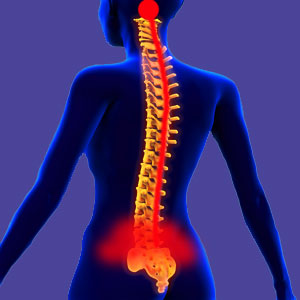
Lumbosacral back pain exists at the juncture between the lumbar and sacral spinal regions. This location is known for being the most common area of the vertebral column for spinal degeneration and is also the site where the most herniated discs occur. Of all spinal zones, the lumbosacral region is implicated in being involved in more acute and chronic back pain complaints than any other area.
The lumbosacral spine has been vilified throughout the traditional and complementary medical systems, mostly unjustly. There is nothing about this area that inherently makes it problematic or susceptible to suffering back pain, although it does tend to express the most noticeable spinal deterioration at the earliest ages of onset.
This discussion provides a complete objective look at lumbosacral back pain problems, including the causes and symptoms of various diagnosed conditions.
Lumbosacral Back Pain Facts
The lumbosacral spine is the area where the lumbar spine (L1 through L5) meets the sacrum (S1). This area exists below the top of the pelvic ilium crests and a few inches above the crease of the buttocks. This is the lowest area of the true back, before the start of the buttocks anatomy.
The actual frontier between the lumbar spine and the sacrum is demarcated by the lumbosacral disc, also known as L5/S1. This disc is well known for being the first to degenerate in the typical human spine, as well as being the disc that most often suffers bulging, herniation and rupture in the human backbone.
The vertebral bones around the lumbosacral spine are also known to suffer the earliest onset of osteoarthritis in most people, as well as the earliest changes that can be considered the beginnings of central spinal stenosis and neuroforaminal stenosis.
Symptoms of Lumbosacral Pain
The symptoms of lumbosacral pain are not necessarily determined by their location, but rather by their origin. There are so many possible causes of lower back pain and each of these might have very different symptomatic expressions associated with it. So, without addressing possible causes yet or correlating symptoms to these causations, let’s simply explore the usual patterns of pain in the lumbosacral region:
Pain might be centered over the spine, off center slightly from the spine unilaterally or might encompass a wide band of suffering on both sides of the spinal column.
Pain may be linked to movement, such as bending forward, twisting at the waist, extending the back or virtually any motion.
Pain might be localized or radiating. Many patients might suffer sciatica symptoms into the buttocks, legs and/of feet. There may be tingling, numbness or weakness in the lumbosacral area or in the legs. Some patients also suffer burning sensations in the spine or surrounding musculature of the lower back.
Causes of Lumbosacral Back Pain
Virtually any of the typical causes of lower back pain can affect the lumbosacral region. As mentioned above, the lumbosacral spine is universally susceptible to herniated discs, spinal stenosis of the central canal, stenosis of the neural foramen and facet joint deterioration. Other common diagnoses that are found here include hyperlordosis, hypolordosis and degenerative disc disease. Less commonly, we observe cases of lumbar scoliosis, spondylolisthesis, transitional vertebrae, and sacralization in the lumbosacral region. None of these conditions are inherently pathological and in fact, most cases are completely innocuous. However, some cases might be painful for a time or over an extended duration in uncommon circumstances.
Of course, injury is always possible at the lumbosacral spine. Injury can indeed cause many types of back ache, but rarely leads to chronic pain, since the body’s primary imperative is to heal and resolve all traumas.
Finally, we must mention the incredibly common scenario of suffering mindbody pain at the lumbosacral juncture. Due to various factors, including our collective negative view of the fragility of the lower back, the common exposure to diagnostic nocebo effect and the high incidence of spinal abnormalities located here, the lumbosacral spine is a region that has the distinction of the being the most common place in the human body to experience psychosomatic pain.





